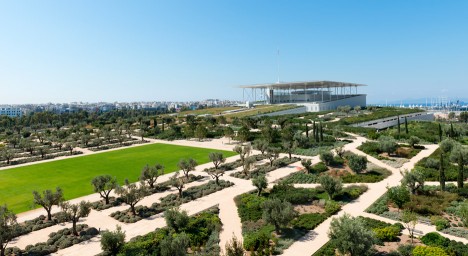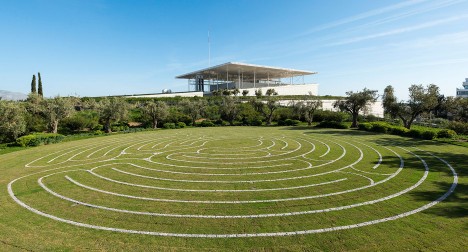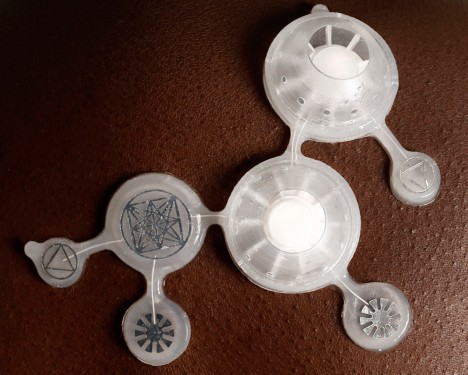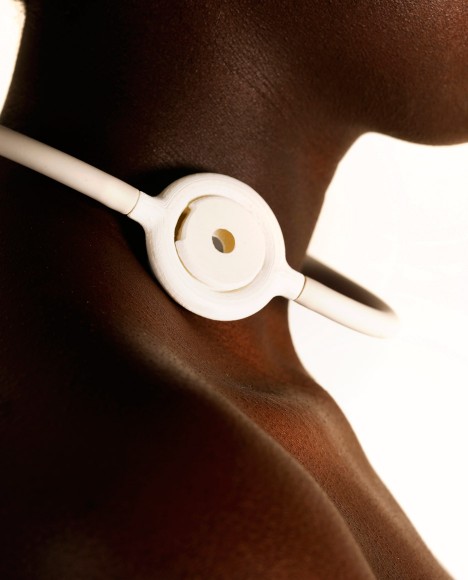"If you want a happy ending, that depends, of course, on where you stop your story."
-- Orson Welles
Monotype overhauls London Underground's 100-year-old Johnston typeface
27 JUNE 2016 DEZEEN EMMA TUCKER
International font company Monotype has brought the London Tube's 100-year-old typeface into the 21st century, adding the hashtag, at sign and lighter weights more suitable for digital use.The Johnston typeface is deployed across Transport for London's maps, signage and posters. It is known for its distinctive diamond-shaped tittle – that is, the dot over a lowercase i.
The typeface was originally created by British artist and calligrapher Edward Johnston, and introduced into the company's train and bus services in 1916.
Monotype's updated version of Johnston, dubbed Johnston100, adds a pair of new weights to the font family – hairline and thin – which have been created specifically for digital use.
Characters that had previously been missing from the original design – notably, the hash (#) and at (@) symbols – have also been included in the update.
... Referring back to archive drawings, Monotype designers Nadine Chahine and Malou Verlomme focused on reintroducing design quirks that had been lost – such as a more angular bowl on the lowercase g. Read More
Renzo Piano completes Stavros Niarchos Foundation Cultural Center on a huge artificial hill
28 JUNE 2016 DEZEEN AMY FREARSON
ATHENS, GREECE (Dezeen) -- Italian architect Renzo Piano has finished a major new park, library and theatre complex in Athens, following one of the largest donations for a cultural building project in history.
Located in the Kallithea district in the south of the Greek capital, the huge Stavros Niarchos Cultural Centre creates new homes for the National Library of Greece and the Greek National Opera, tucked beneath a new 170,000-square-metre sloping park and beside a 400-metre-long rectangular lake.
The project was made possible by a €596 million (£496 million) donation from the Stavros Niarchos Foundation – the charity set up after the death of billionaire Greek shipping tycoon Stavros Niarchos.
Now the complex is complete, the foundation is handing it as a gift to the Greek state, but will continue to contribute to its upkeep.
... "From our first observations there emerged the idea that by raising the ground - with a slight slope and a progressive course - we could restore the 'beautiful view' of Kallithea," wrote Piano in an essay about the project.
"In that way, without realizing it, visitors strolling through the park would find themselves at a height of thirty metres."
The new sloping park, planted with indigenous Greek plants to designs by New York landscape designer Deborah Nevins, forms the roof of the opera house and library. The top of the artificial hill, which rises to 32 metres, is capped by a paper-thin roof held aloft by slender columns.
The 100 x 100 roof, dubbed the "flying carpet" by Piano, is topped by a hectare of photovoltaic panels that generate 2.5 megawatts to power the building. Beneath its shade-giving expanse is yet more sloping public space plus a large glass-walled reading room called the Lighthouse.
At ground level, the opera and the library are organised around a public plaza known as the agora – a reference to the central gathering spaces in Ancient Greek cities.
Inside the library, huge walls of shelving offer storage for its collection, which includes over 5,000 manuscripts, documents, records and engravings, dating back to the ninth century.
Other facilities in this part of the building include a business incubator dedicated to entrepreneurship, a music recording studio, and areas for children and teenagers – all of which can be found on the ground and first floors.
On the opposite side of the building, the opera house features two auditoriums. The first, containing 450 seats, will host traditional operas and ballets, while the grander 1,400-seat hall will be used for "experimental performances".
There are also an assortment of dressing rooms, rehearsal spaces and production areas for costumes and props.
The new park – occupying land that was once home to a horse-racing track – contains thousands of new trees, bushes and shrubs. It includes sports facilities that range from running tracks to a playground.
The Stavros Niarchos Cultural Centre will officially open later this year, once its interiors have been fully fitted out. It becomes the first public building in Greece to achieve a Platinum LEED certification, in recognition of its sustainability. Read More
Wan Tseng's Wisp wearables are an alternative to "intense" sex toys
27 JUNE 2016 DEZEEN EMMA TUCKER
Royal College of Art graduate Wan Tseng has designed erotic devices that provide a subtle, sensation-focused alternative to traditional sex toys.The Wisp wearables include silicone jewellery that's worn around the wrist and neck, and a set of circular pads that stick onto the skin anywhere on the body. The pads emulate the sensation of light grazes, firmer touches and gently blowing breath.
Unlike most electronic sex toys on the market, they focus on the pleasure of stimulation rather than an end goal of orgasm.
"I designed this sensory collection to help women embrace their natural sexuality," the designer told Dezeen. "If you think about the current sex toy market, it's more intense products like dildos or vibrators, which are focused on orgasm.
"I don't think there's much focus on the area I'm working in right now."
The Wisp collection includes a product called Touch, which uses mini motors and a set of five circular silicone pads that sit on the skin to create sensations similar to touching.
The Whisper toy changes temperature and blows air to recreate the feeling of "a lover's breath".
Both objects have been designed to be placed anywhere on the wearer's skin, allowing owners to customise the toys to their most sensitive areas.
The Air necklace includes an air-blower and a speaker, and can also release perfume. Wearers can use the necklace to play music from their phone via Bluetooth, as well as adding their own favourite fragrance to the jewellery.
Tseng designed the collection of toys after interviewing a group of women with different sexual preferences and carrying out research into the different stages of male and female arousal.
"I want to create a better and more beautiful, personal experience for girls," she said. "You directly attach the accessory to the skin, more like a body tattoo."
"It's a new kind of concept. I think it's not a toy, but more like a communication tool for yourself." Read More
My Japanology / Starting from boyhood play in Yokohama
27 JUNE 2016 THE JAPAN NEWS HIROTO SEKIGUCHI
TOKYO, JAPAN (Yomiuri Shimbun) -- These days, kids grow up with technology gadgets such as smartphones, and are exposed to virtual reality on the screen. Adults might think that our children are no longer playing with toy cars. However, Harold Meij, the first foreign president of toy maker Tomy Co., says traditional physical toys can attract children’s interest by creating connections with digital technologies. The Dutch executive, who was himself a big fan of Tomy’s die-cast cars as a boy, spoke about his vision.Q: You lived in Japan during your childhood. Did you play with Tomy’s toys at that time?
Meij: Yes. I came to Japan for the first time when I was 8 years old. My father had a job at a Japanese company.
Obviously I didn’t speak Japanese. But the problem was I didn’t speak English either. At that time I just spoke Dutch, because I was 8 years old. So you only speak one language.
Because I went to international school, everything at school was English. I didn’t know the words “yes,” “no,” nothing. But once I was outside of school, everything was in Japanese, which I didn’t know a single word of either.
So I was completely lost. I didn’t have friends. I could watch TV but I had no idea what they were talking about. And my father worked for a Japanese company: Back then, he worked Saturdays. So I never got to see my parents either. They were very busy.
All I had was toys, basically, to just play with myself. And back then, it was very common to go play in parks. So there was a little park near where I was living in Yokohama, and I was just sitting there and playing with what now are Tomica (Tomy’s die-cast cars).
And I was playing with them and other kids came over. They were talking to me in Japanese, which I didn’t understand.
But they were saying something about the cars, obviously, the Tomica. I didn’t know what. I don’t know if it was good or bad. But they were saying something. And that’s how communication started.
And it’s like, oh, well I have a Tomica, too, kind of thing. Oh, I know that one, because I’ve seen that around. So it’s all about hand communication really.
Everyday Exploration / Social change seen in hire-a-priest servicesBut that’s how it started. And that’s how single words came out like “kuruma” (car), “iro” (color), “aka” (red). So I slowly started to learn the language and make friends. The thing that allowed me to do that was the Tomica. Read More
27 JUNE 2016 THE JAPAN NEWS TAMOTSU SAITO
OSAKA, JAPAN (Yomiuri Shimbun) -- An increasing number of people are using internet services to arrange for monks to hold funerals and Buddhist memorial services, instead of using ones from their family temples.... Detachment from temples
Terakuru started in 2012. It currently has registered 450 temples from eight different sects nationwide. The number of monthly users has risen from an initial 150 to 500.
Tomomi Hatta, general manager of sales at management company Uniquest Online Inc. in Osaka, said: “When monks are eager to provide superior service, they try to give Buddhist sermons that are easily understood. That gives users satisfaction.”
Dispatch monk services with fixed-rate pricing have become noticeable over the last five or six years. Today, scores of companies offer such services.
In December last year, major internet retailer Amazon Japan G.K. began dealing with Obosan-Bin, or monk post, a service of Minrevi Co. in Tokyo, a company involved in the funeral industry. The service has attracted considerable publicity.
The popularity of such services derives from the current situation of users, as well as temples.
From the users’ point of view, more and more people are not affiliated with a family temple. They are also not satisfied with the cost, thinking things such as, “I’m not sure how much I should pay for a funeral or Buddhist service,” and “The cost for a dharma name varies from ¥150,000 to ¥1 million..." Read More
 |
| Linda Evanelista, Naomi Campbell, Christy Turlington |




No comments:
Post a Comment